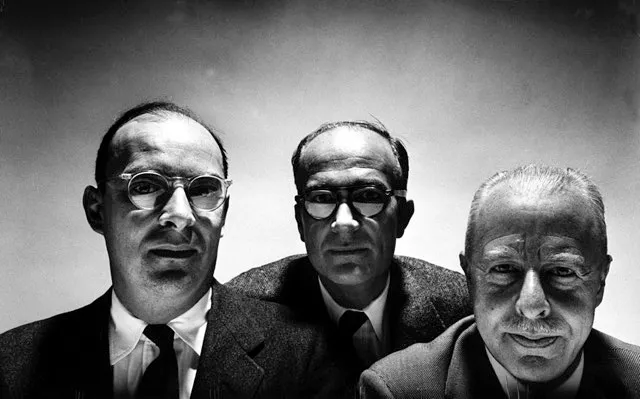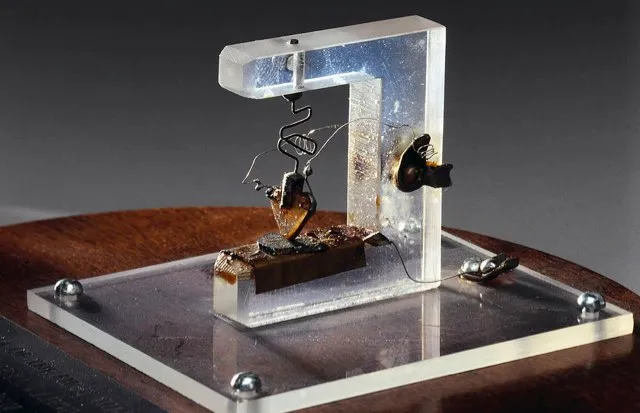Only one person has ever won two Nobel Prizes in Physics. But unless you happen to be a physicist yourself, chances are you’ve never heard of John Bardeen.
Contrary to the usual stereotypes, he was neither an egomaniac nor a tortured genius. A loving husband and father, he was a gracious man with a sweetness of spirit who loved to play golf with his buddies on the weekends.
He made his first important discovery while working for Bell Laboratories, the research and development arm of the American Telegraph and Telephone Company, soon after World War II. At that time AT&T had a big problem: they needed to come up with better amplifiers.
Read more about great scientists:
- Three famous chemists who changed our understanding of the central science
- Arthur Eddington: the champion of relativity
- James Clerk Maxwell: the great scientist with a profound impact on modern physics
When people made long-distance calls, the electrical signals carrying their voices would weaken and dissolve into static if they weren’t amplified along the way. Vacuum tubes were still the only amplifiers available. Invented in the early 1900s, they were modified light bulbs that could magnify electrical currents, or reduce them, or block them entirely. They could pull a weak electromagnetic signal out of the air, boost it back up, and convert it into sounds or pictures.
Vacuum tubes made the first radios and televisions possible. On the other hand, they consumed a lot of power, needed time to warm up, and tended to get very hot. (In my own childhood days, I remember being fascinated by the glowing tubes inside our television set. Frequently one would burn out and a TV repairman would have to come by to replace it.)
The director of Bell Labs, a physicist named Mervin Kelly, had a hunch that a new kind of amplifier could be built from crystals of materials called semiconductors. Not much was known about them at the time, but they were intriguing. Semiconductor materials (like silicon or germanium) could conduct electricity better than insulators (like rubber or glass) but not as well as metals (like copper or gold). Their in-between character seemed promising. Perhaps their electrical flexibility could be useful.
Read more about the history of science:
- As history proves, women in science need more than just a lab coat
- Nazis, magic and McCarthyism: the dark history of early American space exploration
In metaphorical terms, any material’s ability to conduct electricity can be understood by picturing the electrons buzzing around its atoms as being like people sitting in rows of seats in a theatre-in-the-round.
For quantum mechanical reasons, the electrons fill the rows closest to the stage first. If all those seats are taken, the electrons fill the next row, and so on. Once a row gets filled, the electrons in it find it difficult to move so they tend to stay put (just as people find it hard to get up and move past those sitting next to them in a crowded theatre). Once all the rows are filled, the material acts like an insulator. It cannot conduct electricity very well, because it lacks the loose electrons needed to carry a current.
Metals, on the other hand, have lots of loose electrons roaming around in the mostly empty outer rows far from the stage. These electrons in the back of the theatre can easily get up and switch seats or even wander off (perhaps to check out another theatre or atom), which is what lets metals conduct electricity so well.
Semiconductors lie in between these two extremes. They are mostly made of atoms that don’t conduct electricity very well but have a few atoms that do. So a semiconductor can go either way. You can toggle a semiconductor to act more like an insulator or more like a conductor by shining light on it or injecting charge into it or changing its temperature.
This flexibility is what makes semiconductors so potentially useful. But at the time Bardeen was hired, nobody knew enough about their basic physics to see how to make amplifiers from them.
Bardeen, Shockley and Brattain
Bardeen’s team leader at Bell Labs, a physicist named William Shockley, had an idea for an amplifier using a crystal of silicon, but it didn’t work. He asked Bardeen and his office mate, Walter Brattain, to figure out why.
Using his knowledge of calculus and quantum mechanics and building on his PhD thesis about the behaviour of electrons in metals, Bardeen realised that electrons at the surface of the silicon crystal could conspire to form an electrical screen. His calculations showed that those surface states prevented the semiconductor from working as an amplifier.
The day the transistor was born, John Bardeen drove home, parked his car in the garage, and told his wife, “I think we discovered something today.”
Guided by Bardeen’s mathematical insights, his colleague Brattain – who was a wizard in the lab – scrapped Shockley’s design and tinkered with many others. Bardeen would suggest ideas, develop mathematical models, and interpret Brattain’s experimental results, while Brattain would build the gadgets, run the experiments, and collect the data.
On the afternoon of 16 December 1947, they finally got something to work. Using germanium, plastic, and gold, Bardeen and Brattain made the world’s first semiconductor amplifier. They would later call it a transistor.

Transistors are such an integral part of our lives today that we barely notice them. They gave us pocket-sized transistor radios in the 1950s, then portable televisions, videocassette recorders, and compact disc players.
They were exceptionally versatile. Besides amplifying electricity, they could switch it on or off. That made them ideal as the basis for a second generation of computers, digital computers whose binary logic of true and false, 1 and 0, could be encoded by the on and off states of transistors.
By the late 1950s, these transistorised computers replaced giant vacuum-tube beasts like ENIAC, a 30-ton behemoth that filled a large room at the University of Pennsylvania, where it was used in the late 1940s for hydrogen bomb calculations. (ENIAC’s 18,850 vacuum tubes consumed so much power, it was rumoured, that it made the city lights flicker every time it was turned on.)

Compared to tubes, transistors were lightweight, efficient, durable, and cheap. And they could be made very, very small. In the years to come, other engineers and scientists would figure out how to pack millions of them on a chip, the devices we now know as integrated circuits.
And as chips became smaller, everything became smarter. Cars started more efficiently. Hearing aids shrank. And for people with chronic heart conditions, pacemakers went from portable to wearable to implantable.
The day the transistor was born, John Bardeen drove home, parked his car in the garage, and told his wife, “I think we discovered something today.”
Cracking superconductivity
Nine years later, he was frying eggs for breakfast one morning when his kids rushed into the kitchen, screaming that they’d heard on the radio that he’d won the Nobel Prize in physics. Bardeen dropped the frying pan on the floor and ran into the bedroom to tell his wife the news.
It was exciting, but not as exciting as what he was working on at that moment. He was engrossed in another mystery of quantum mechanics, an almost surreal phenomenon known as superconductivity, in which certain metals suddenly lose all resistance to the flow of electricity at temperatures close to absolute zero.
Every luminary of 20th Century physics had taken a crack at explaining superconductivity, from Albert Einstein to Werner Heisenberg to Richard Feynman. But none had solved it. Bardeen did, along with two younger colleagues. Sixteen years later, he returned to Stockholm to receive his second Nobel Prize in physics. Today, superconducting technology is used in the world’s most sensitive detectors of magnetic fields, with applications ranging from oil prospecting to medical imaging.
John Bardeen died in 1991. Some of his neighbours never knew he’d invented transistors and explained superconductivity, or that he was the only person in history to win two Nobel Prizes in physics. They remembered him as a modest, unassuming man who liked to grill hamburgers for the neighbourhood and who would always ask his guests if they wanted the bun toasted, which was how he liked it.
Infinite Powers: The Story of Calculus by Steven Strogatz is available now (£20, Atlantic Books)
Follow Science Focus onTwitter,Facebook, Instagramand Flipboard